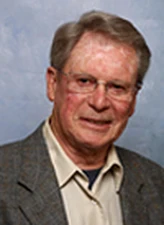Roland von Huene

The 2010 Arthur Holmes Medal & Honorary Membership is awarded to Roland von Huene for his outstanding contribution to the understanding of the geological processes of subduction zones.
Roland von Huene has led fundamental new research on the quantification of geological processes at convergent margins spanning a wide range of topics that include tectonics of subduction erosion and accretion, the formation and evolution of the continental crust, the generation of interplate earthquakes and fluid flow out of descending slabs and accretionary prisms.
Von Huene’s work has shown that half of the world’s convergent margins conform to the conceptually accepted accretionary model, but that the other half are dominated by tectonic erosion where overriding plates are tectonically thinned. He showed that the rates of tectonic erosion are significant, and estimated that they may be as high as the rates of crustal generation at arcs, also showing that there may have been a long-standing balance between both processes. He predicted that considerable volumes of sediment on the incoming plates are subducted to great depths under arcs and that the products of tectonic erosion should also reach the upper mantle; predictions that have been later corroborated by geochemical studies of arc volcanism finding the traces of those subducted materials.
Von Huene also showed already in the 1980’s that drilling a margin overpressured by pore fluid must play a fundamental role in the geometry and tectonics of shallow regions of subduction zones, and later expanded on the implications for interplate earthquake generation. He has also showed that fluid flow driven by tectonic shortening is intimately associated with the tectonic style of upper plate deformation, for both accretionary and erosional convergent margins.
His numerous findings are not the product of serendipity or a lucky strike of “being at the right place at the right time”. Throughout his entire career von Huene has aggressively pursued the discovery of new scientific ideas with a world-class leadership in the collection of observations. He was co-chief scientists of five DSDP and ODP legs drilling the margins of Alaska, Oregon, Central America, Japan and Peru, and chief scientist of 21 other oceanic research cruises of the 45 cruises he has participated in.
Von Huene’s leadership is also supported by his clarity of scientific insight that compels colleagues and students to join his quest for responses to fundamental problems. This was visibly confirmed when he became one of the scientific founding fathers of GEOMAR (currently IfM-GEOMAR), shaping and leading as Director the Marine Geodynamics Division (one of the four original divisions) for almost a decade .
He has also pioneered the way academia approaches the study of geology with geophysical methods. Being fanatical about obtaining the best possible observations, he has mastered state-of-the-art geophysical imaging tools, even at times when they were typically only used in top industry labs. And, he has always been committed to testing his own published interpretations of geophysical data using geological ground-truthing of the sub-seafloor structure with drilling.
In spite of his long career, first at the U.S. Navy, afterwards as branch-chief and several years of managerial work at the USGS, before his most intense academic phase, he has being able to keep a remarkably voluminous publication rate of leading edge ideas, and has co-authored over 170 articles in top journals and books, being the first author of over 50 of them.
Von Huene is currently emeritus professor at USGS Menlo Park, IfM-GEOMAR and UC Davis, he is a fellow of the AGU, and has received other important recognitions for his scientific career including the Gustov Steinmann Medal of the German Geologische Vereinigung. He currently spends much of his part-time research efforts on the design and implementation of new experiments. He is leading an experiment for high-resolution seismic imaging ahead of deep marine drilling. His ideas to image the seismogenic plate boundary of subduction zones and test concepts about earthquake generation soon will be carried out using the new riser ship Chikyu within the IODP offshore program near Japan.
Medal lecture video (Youtube) of the Arthur Holmes Medal given at the EGU General Assembly 2010.
